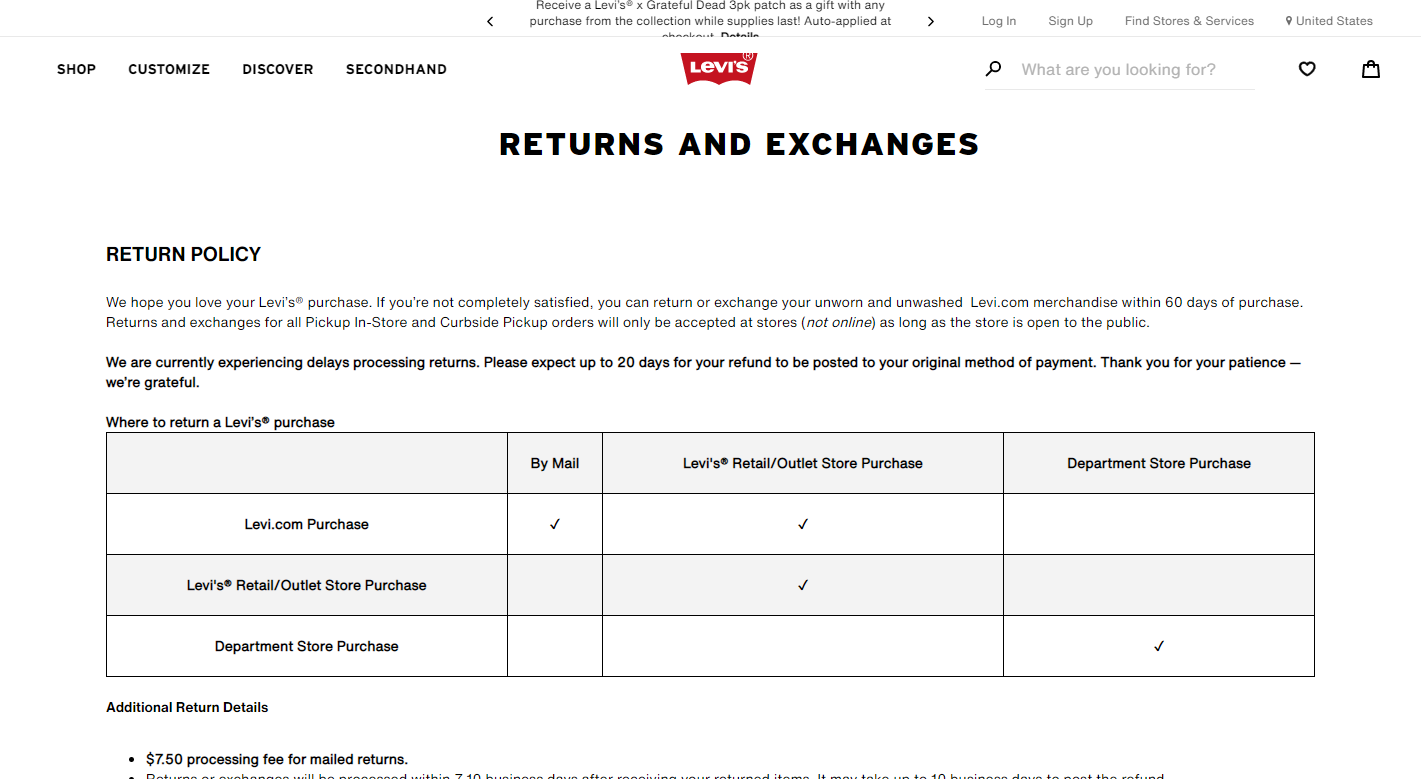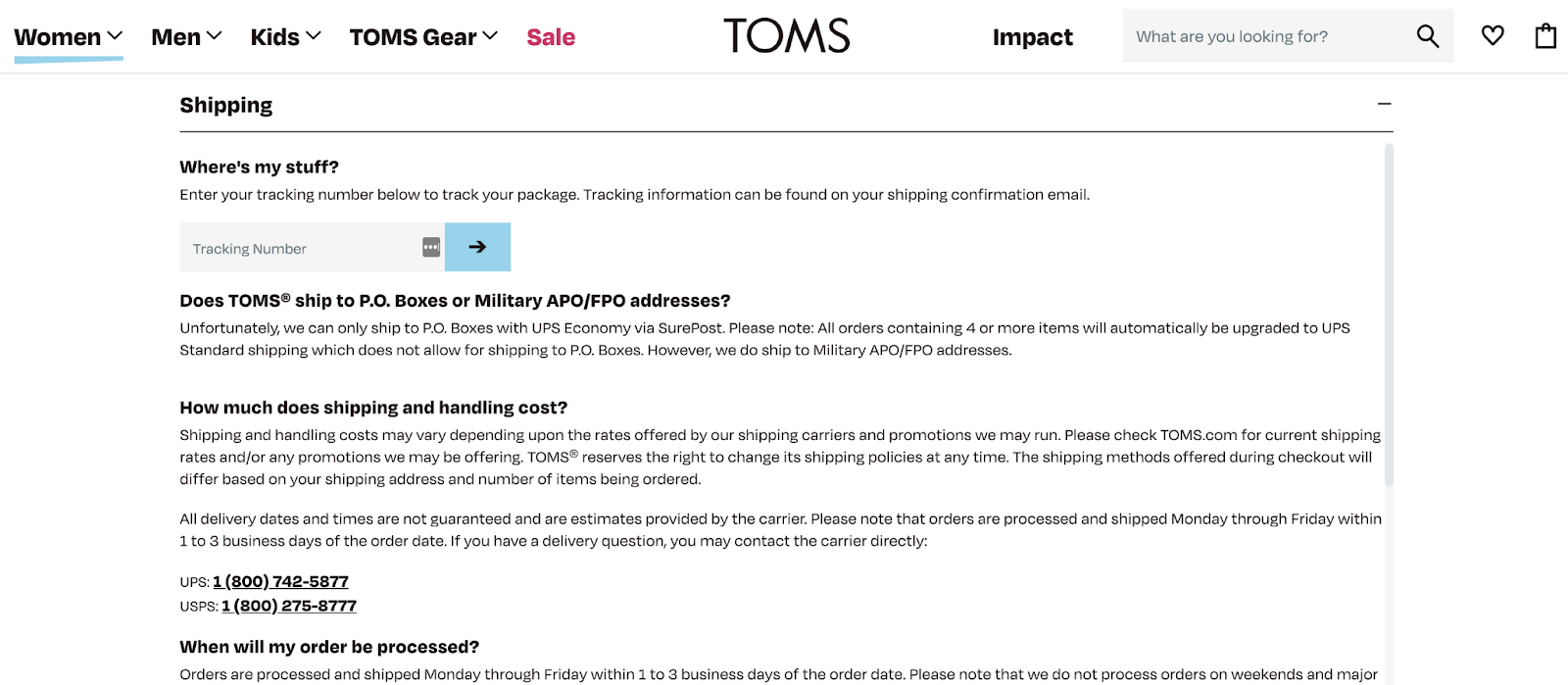
AI-powered delivery date estimates to boost conversion
Give shoppers peace of mind and protect and grow your bottom line
Personalized tracking experiences to build brand loyalty
Returns and exchanges management to mitigate fraud and reward best customers
Proactive communication to drive customer lifetime value
Delivery claim management to tackle fraud and build trust
The Store Policies You Need as an Online Retailer

What’s the ultimate dynamic duo of the ecommerce post-purchase process? The proper fulfillment and return solution for your business, plus customer-friendly store policies. Combined, these two resources help create an ideal experience that builds loyalty and drives repeat purchases.
It’s true: transparency is supremely important for today’s online shoppers. In fact, more than 63% of consumers said they would not make a purchase if they can't find the return policy, for example. That peace of mind guides the sale, and then scalable technology (think: shipping labels, tracking, returns processing) helps earn customers’ trust.
Shoppers want to know exactly what to expect from the start. They don’t want to deal with any last-minute surprises. A comprehensive set of online store policies will address common questions and concerns.
Here are the store policies you need to drive sales.
What is an online store policy?
An online store policy is a set of rules that concisely outlines what customers can expect when making a purchase from you. An online store policy covers how the overall purchase process works and includes the specific protocols you have in place for handling situations that may arise, such as processing refunds and returns.
The purpose of an online store policy is to ensure that both your business and your customers are on the same page and to minimize the potential for misunderstandings. When done well, such policies help customers to feel more confident buying from you, and give you a place to point customers to whenever questions arise. In this way, store policies can help protect your company from disputes by eliminating unnecessary friction.
What does a store policy cover?
While every online store policy will be a little different, there are several common areas you may want to cover.
- Returns
- Refunds
- Shipping
- Payment processing methods
- Applicable taxes
- Packaging
- Size charts (if you sell clothing or shoes)
- Applicable warranties
- Coupons, promotions, and discounts
- Customer service channels
How do you write an online store policy?
The process for creating a store policy is pretty straightforward. The key to writing a great policy is to keep it as simple as possible, while still addressing key concerns shoppers may have.
At the end of the day, customers should be able to quickly scan through your policy and extract critical information without having to dig too deeply for the answers to their questions. As much as possible, you want to avoid including complicated jargon and overwhelming shoppers with extraneous details.
With returns, for instance, an online store policy should mention the following.
- The criteria for making a return
- Any exclusions (such as for intimate items or final sale purchases)
- How your returns process works
- The different methods customers can use to make a return (such as dropping it off at a nearby location or scheduling a home pickup)
- The time period in which customers must request returns
- How long it takes to process a return on average
- How customers will receive their refund (such as store credit or a refund to their initial payment method) as well as an accurate estimate for when they can expect their refund to be issued
One helpful tip for writing a successful online store policy is to put yourself in the shoes of your customer. Ask yourself what essential information you’d want to find and structure your policy accordingly.
Online store policy examples
To better illustrate the nuts and bolts of online store policy creation, let’s take a look at a few real-life examples from successful brands.
Return policy example
Consider this return policy example from Levi’s, which clearly describes:
- The amount of time customers have to return items (in this case, 60 days from the date of purchase)
- Where items can be returned, based on where they were initially purchased
- How long customers can expect to wait before their refunds are processed (including a note of appreciation for customers’ patience with delayed return processing during the pandemic)
- Return fees customers may be subject to, as well as guidance on initial costs that may not be refundable (e.g. shipping and handling fees, gift wrap charges, and donations)
- Payment processing methods available for refunds, in addition to details on who bears responsibility for any return shipping fees incurred

Levi’s also includes a “Start Your Return” link within its return policy, making it easy for customers who want to act on the information they’ve just read to get started.
Refund policy example
In this refund policy example, Lululemon’s ‘Fast Track Refund’ policy allows purchasers of select items to receive a refund for their returned goods via e-gift card in just a few hours.

Fast Track returns are only available to customers who are returning three or fewer items, and are not available for Like New products. However, by making such speedy refunds available to some customers, Lululemon distinguishes itself from brands offering slower repayment terms, giving buyers a compelling reason to shop the store.
Shipping policy example
In this shipping policy example, apparel and shoe company TOMS provides clear answers to common questions on their shipping policies page, and even takes it a step further. Knowing that customers might arrive on the page looking for help with their orders, the first entry in their shipping FAQ is a search feature that allows customers to enter their tracking number for up-to-date information on their order status.

From there, the company:
- Explains that they don’t ship to P.O. Boxes or Military APO/FPO addresses
- Clearly describes their shipping costs
- Describes when products are processed and shipped (in this case, 1-3 business days after the order date)
- Offers helpful contact information for UPS and USPS, if it’s needed
The company also explains that TOMS.com doesn’t ship orders to international addresses, but that customers can ship to select countries through their international websites via the included links.

Taken together, these elements help answer any questions shoppers may have about TOMS’ shipping and may help minimize their anxiety to boost conversion rates.
Where should your online store policies live?
As for the location of your online store policies, most brands place a link to their policy page in the footer of the website. However, this isn’t the only place you should be mentioning your policies. Linking to them in multiple places makes them more visible to visitors and ensures important questions don’t go unanswered.
For instance, of the retailers reviewed in Narvar’s recent Returns Benchmarks Report:
- 45% of Fortune 50 retailers link to their return policies from the top navigation or banner, compared to just 6% of omnichannel retailers and 14% of direct-to-consumer (D2C) brands.
- 64% of Fortune 50 retailers mention returns in their product detail pages (PDPs) and have a link in their global navigation, beating out 46% of omnichannel and 39% of D2C sellers.
- Just 18% of Fortune 50 retailers only link to their return policies in the website footer, compared to 34% of omnichannel and 26% of D2C brands.
No matter how large or small your company is, you can easily take a page out of these Fortune 50 retailers’ playbooks by adding your store policies to multiple locations on your site.
Ultimately, store policies may seem deceptively simple, but they’re still worth getting right. By investing in customer-friendly store policies, you’ll build the kind of trust that keeps them coming back again and again.
Get more insights from the experts
GET STARTED
Power every moment after the buy
Build trust. Protect margins. Drive growth — “Beyond Buy.”




















